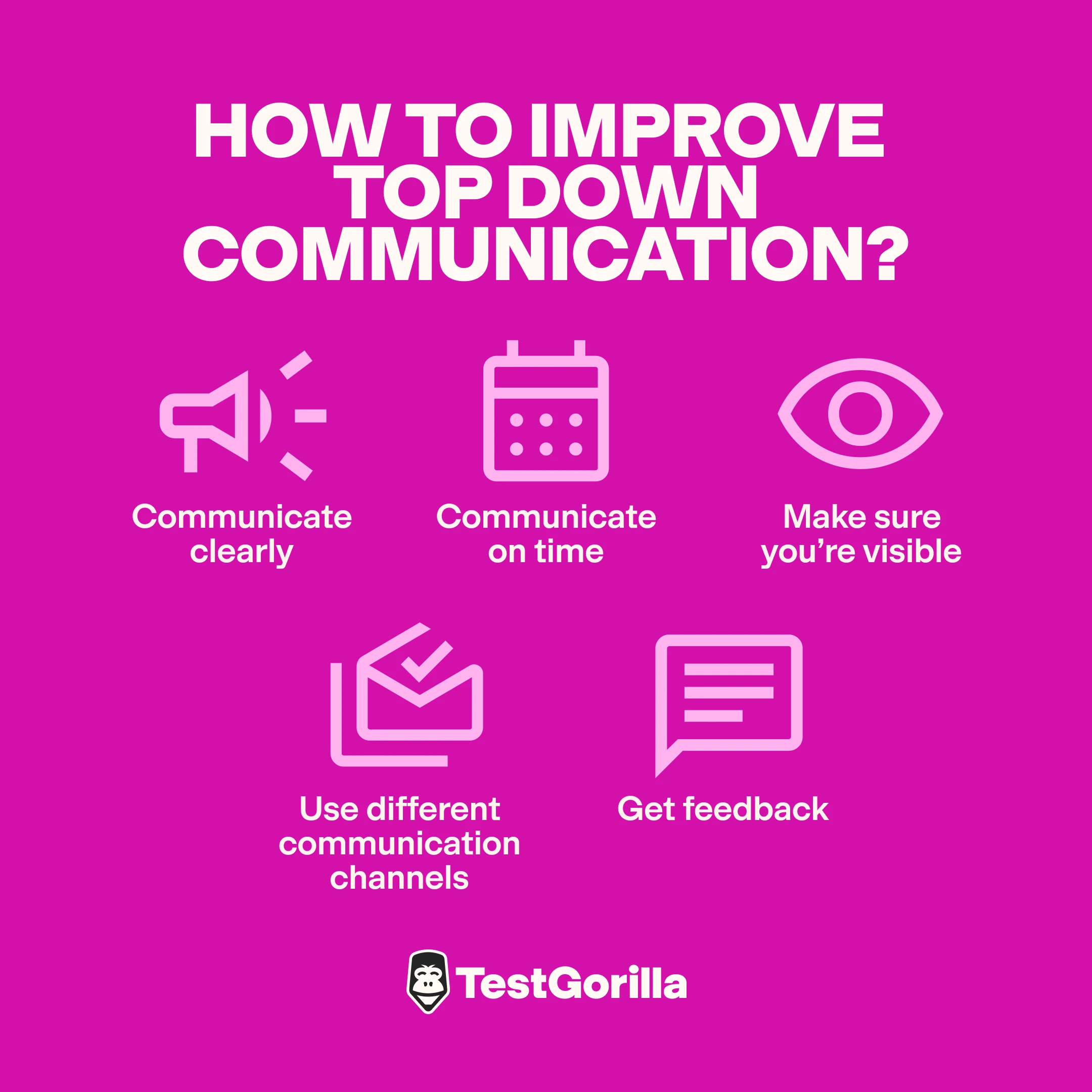What is top down communication? How to get it right in your business
When properly executed, top-down communication helps set clear expectations and accountability, explain objectives, and ensure each employee receives relevant information from leadership.
But like any productive conversation, communication in a healthy workplace requires the involvement of all parties – otherwise, it’s just a monologue.
Without a chance to meaningfully contribute, employees are likely to feel unvalued and disengage from work.
In this article, we explain how to improve top down communication, perpetuate a culture of transparency and information sharing in your company, and recruit excellent communicators through skills-based hiring.
Table of contents
- What is top-down communication?
- What is bottom-up communication?
- Why is top-down communication important?
- Pros and cons of top-down communication
- Examples of top-down communication
- How to improve top down communication in your company
- Build a culture of visibility with TestGorilla
- Improve your top down communication with TestGorilla
- Top down communication FAQs
What is top-down communication?
Top down communication refers to all information that travels from leadership down the chain of command. The top down approach to communication efficiently transmits information from senior management to employees so that everyone knows exactly what’s expected of them, how to achieve it, and why it’s important to the company.
A top-down communication strategy is directly linked to your company’s culture, and it impacts how your employees interact with each other and with management.
Effective top-down management streamlines tasks, encourages feedback from the bottom up, and helps fuel business growth.
What is bottom-up communication?
Bottom-up communication is information that travels up the chain of command, from first-line workers to senior management.
Rather than looking at top-down vs bottom-up communication as two mutually exclusive techniques, see them as what they are: two parts of a whole.
The bottom-up communication style enables employees to share their feedback, such as:
Valuable real-time insights from their work, which help inform leadership decision-making
Their experiences and satisfaction with the work environment, so you can support them better and retain them longer
Being listened to by superiors in this way helps build trust and a stronger connection between employees and their organization.
When you make the bottom-up approach a standard part of your culture, it enhances overall communication, shows you put people first, and makes your employees feel appreciated and included.
The best insights on HR and recruitment, delivered to your inbox.
Biweekly updates. No spam. Unsubscribe any time.
Why is top-down communication important?
Leadership communication can make or break a business.
According to the Society for Human Resource Management, poor communication causes an average loss of $62.4m per year in large companies.
Top down communication, in particular, is crucial because it’s the cornerstone of all communication in the entire company:
It directly affects employee performance and satisfaction: When instructions and performance metrics are clear, employees can work efficiently, self-evaluate more accurately, and be more productive
It helps to foster bottom-up communication: When leaders are open, honest, and communicative, it encourages a culture of strong communication among all employees
Pros and cons of top-down communication
Below are the pros and cons of the top down communication approach that you should be aware of:
Pros | Cons |
- It establishes clear authority - It maintains quality control - Reduces the risk of mistakes caused by inaccurate information - Ensures everyone aims towards the same strategic goals and initiatives - Only relevant information reaches employees depending on their seniority and status - Enhances employee engagement on a large scale | - Communication may get misconstrued as it travels down the chain of command - Details may get lost when something is communicated en masse - There’s a risk that sensitive information may leak out to competitors - Unfiltered information can cause a rift between employees and senior management - Too much information may cause confusion or even resentment in employees |
Examples of top-down communication
Let’s say a project comes in that requires several departments to work on it separately before coming together to create the final product. While most departments are autonomous and agile, they risk working in silos.
When that happens, important details that would make the work easier, like the status of another team’s progress, never get communicated. This can translate to a slower production process or missed deadlines.
Effective top-down communication can alleviate such problems by giving the same information to all project managers. That way, all departments learn from each other, know what everyone else is working on, and save precious time.
Another example could be when colleagues have a mishap that management needs to resolve. If there are no clear guidelines on what to do in such a situation, different departments may solve the problem differently.
One department may take a proactive approach, sitting down with the employees in question to try to air out the problem, while another department may want to hide the problem under the rug, where it would fester and result in an even bigger issue.
With top-down management, you provide consistent guidelines that everyone must follow. This solidifies your workplace culture, facilitates easier problem-solving, and prevents unpleasant surprises.
A final example is McKinsey’s Minto Pyramid Principle, a proven structure for helping firms and leaders communicate clearly from the top down. This principle states that the most important information must always come first to avoid misunderstandings and immediately capture the audience’s attention. Then, you have time to put together arguments to summarize the main points and add supporting details.
How to improve top down communication in your company
Top down communication often fails due to several factors:
Lack of bottom-up knowledge: You’re missing important information about your employees and are unable to fully support them.
Complex messaging: A great idea that isn’t clearly communicated can be butchered in execution or take longer to bear fruit.
Unfiltered, irrelevant messaging: When employees get bombarded with irrelevant information, they become disengaged. They might turn the notifications off and even miss the memos that do concern them as a result.
Follow these five practices to improve your workplace communication:
1. Communicate clearly
Don’t burden employees with unnecessary details.
When presenting a new idea or project, explain the big picture first and then go into more detail if necessary. If a piece of information is important to the legal team but not the engineering department, don’t share it with the latter, as it may confuse them.
To achieve this, it’s essential to have good communicators on your team. Having people who can communicate clearly and listen carefully to others makes a huge difference to your organization.
TestGorilla’s Communication test gives you an objective way to measure this soft skill in potential hires. It’s designed to test candidates for all four types of communication: written, verbal, non-verbal, and visual.
Make data-driven hiring decisions with TestGorilla
Talent assessments give you complete, objective information about your applicants. Learn how easy it is to assess key skills and hire the best-matched candidates with TestGorilla.
2. Communicate on time
When you have a time-sensitive project, be prompt with your business communication. Leaving things to the last moment can cause employees to stress out and make them more prone to errors.
In addition, if something is happening within the company that will affect everyone, communicate that with your employees promptly. Don’t risk them finding it out from another source like social media.
If they do, it can lead to a loss of respect from your employees, and rumors are bound to erode their confidence in you.
3. Make sure you’re visible
Employees want to hear and see their leaders often and feel connected to them.
Being visible as a leader boosts morale and encourages better communication, so make sure you put yourself out there and remain open to connecting with your employees.
A simple way to do this is to ensure you’re approachable. Saying hello and taking an interest in what people are doing goes a long way.
Lead with humility and honesty, emulating the best qualities of a servant-style leader. For more details, read our article about leadership and management styles.
4. Use different communication channels
Using different communication methods helps you transmit important information to your employees.
Instead of just opting for emails that can easily be overlooked, try to be innovative by filming a short video or using a pop-up message on internal computers, ensuring that everyone gets your message.
Additionally, be sure to maintain consistency between internal communication and external channels like your LinkedIn company page.
5. Gather feedback
When employers habitually get and implement feedback, it benefits the whole company. On your employees’ end, it makes them feel heard at work, which in turn makes them more effective in their roles, connected to you as an employer, and more engaged.
It gives you, as the employer, useful expert insight that feeds into your strategy and helps you build a thriving, productive workforce.
Make sure to ask about your employees’ concerns and opinions frequently:
Create space for feedback in your dedicated 1:1 meetings
Tune into how team members are doing on a daily basis
Share your thoughts and feelings to normalize it for colleagues
Instead of taking the lead, ask employees if there’s anything they want to talk about
Pulse surveys and anonymous questionnaires are also helpful in understanding how your employees are feeling and ensuring important details don’t slip under the radar.
Build a culture of visibility with TestGorilla
Strong top down communication comes naturally with candidates who already possess communications skills, especially in leadership positions.
The trick is knowing how to identify them.
Soft skills are often perceived as less important and more vague, so they’re harder to measure quantitatively in candidates. This opens up room for biased conclusions: “This candidate is charming, so surely their communication skills are good.”
Costly hiring mistakes often follow.
Talent assessments are a great way to add objectivity to the evaluation process. That’s exactly why Contentoo uses TestGorilla talent assessments: It helps the company eliminate bias, create solid benchmarks for applicant testing and ranking, and make data-driven hiring decisions.
For the mentioned soft skills, your candidate assessment can include a Communication test, a Culture add test, and a Motivation test.
Our Communication tests evaluate applicants’ verbal and written communication skills, active listening, interpretation, and responsiveness to non-verbal cues.
We have two versions for different levels. Here’s a sample question from the Entry level Communication test:
Below is a sample question from the Intermediate Communication test:
Many of our hard skill evaluations for people-oriented roles also include elements of communication.
You can mix and match talent assessments to create a custom combination to match the leadership style you’re looking for in any job description.
Transform your hiring process with TestGorilla
Getting started with TestGorilla is quick, intuitive, and 100% free. Simply create your account and craft your first Communication skills assessment today.
Improve your top down communication with TestGorilla
Communication should be a two-way street.
Facilitating top down leadership communication is an effective way to engage employees and create an open and communicative environment among your workforce.
One of the best ways to improve top-down communication in your company is to hire people with the right skills and mindsets.
Look at TestGorilla’s product tour or book a demo to see how our talent assessments make it possible.
Ready to begin? Create a Free forever account and start testing today with our free Communication test!
Top down communication FAQs
Below are the quick answers to your top down communication questions.
What is top down and bottom-up communication?
Top-down communication means that information starts from leadership and travels down to lower-level employees. In contrast, bottom-up communication is when information travels from first-line workers to senior management.
What are the advantages of a top-down approach to communication?
Establishing clear authority
Maintaining quality control
Engaging employees
Reducing the risk of mistakes
Aligning everyone towards the same company goals
Ensuring employees only receive relevant information
What are the disadvantages of top-down communication?
Details may get lost when something is communicated en masse
Risk of sensitive information leaking out to competitors
An overload of unclear information may cause confusion or even resentment in employees
You've scrolled this far
Why not try TestGorilla for free, and see what happens when you put skills first.




















